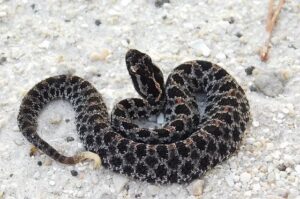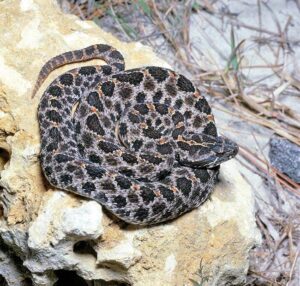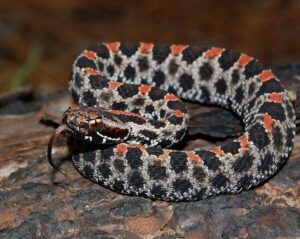Dusky Pygmy Rattlesnake (Sistrurus miliarius barbouri)
Updated on
25/04/2024The dusky pygmy rattlesnake is a short, thick-bodied pit viper endemic to the southeastern US. The subspecific name barbouri is in honor of American herpetologist Thomas Barbour. Other common names of the species are Barbour’s pygmy rattlesnake, ground rattlesnake, Florida ground rattlesnake, pygmy ground rattlesnake, hog-nosed rattler, pygmy rattler, small rattlesnake, pygmy rattlesnake, and southeastern ground rattlesnake.
Scientific Classifications
- Suborder:Serpentes
- Family:Viperidae
- Genus:Sistrurus
- Species:S. miliarius
- Subspecies:S. m. barbouri
Conservation Status
Description

Size
The total length of an adult, including the tail, is 14-29.9 in (35.5-76 cm). The largest recorded size is 25.1 in (63.8 cm) of a specimen from St. Petersburg, Florida.
Color and Appearance
The snake has dorsal, rounded spots on a light to dark gray ground color. The spots disrupt a reddish-brown stripe running down the middle of the back. There are generally 23 rows of dorsal scales at the midbody. The whitish belly is mottled or heavily flecked with dark brown or black. The slender tail ends in a tiny rattle.
Are They Dangerous to Humans
When frightened, the snake remains motionless and flattens its body against the ground. If provoked, it tries to flee or may stay coiled and shake its tail producing a faint buzzing sound akin to a buzzing insect. Further provocation leads it to bob its head and strike. But the serpent avoids direct contact with humans and is not aggressive. Most bites occur when it is accidentally stepped on or intentionally molested.
The pygmy ground rattlesnake’s bite can be very painful and cause swelling despite treatment. But the bite is not considered to the life-threatening to people or pets. The hemotoxic venom contains a family of proteins that causes blood to clot. It can be prevented by prompt medical attention.
Dusky Pygmy Rattlesnakes at a Glance
Distribution
It ranges from the extreme south of South Carolina through southern Georgia, Florida, west through Mississippi, southern Alabama, and Louisiana.
Habitat
It inhabits moist or wet lowlands, woodlands, marshes, and freshwater floodplains. It is frequently found under logs, in stumps and animal burrows in its habitat.
Lifespan
The pit viper lives for up to 20 years.

Predators
The dusky pygmy rattlesnake falls prey to mammalian carnivores, raptors, and snakes that eat snakes. The color and pattern of its scales offer excellent camouflage against its enemies.
Diet
They consume a wide variety of small prey, including lizards, centipedes and other arthropods, frogs, other snakes, and small mammals. They actively pursue their prey, making use of their scent trails, but, in most cases, wait to ambush prey.
Reproduction
Ovoviviparous (gives birth to live young from eggs that hatch inside the body)
Between July and August, a female gives birth to 5-7 young in a litter. The neonates measure between 6.2 and 6.8 in (15.7 and 17.3 cm) in total length. They are the same color as the adults, except their tail tips are bright sulfur-yellow.
Source
stjohnsriverecotours.com, savethebuzztails.org, monaconatureencyclopedia.com, venombyte.com







